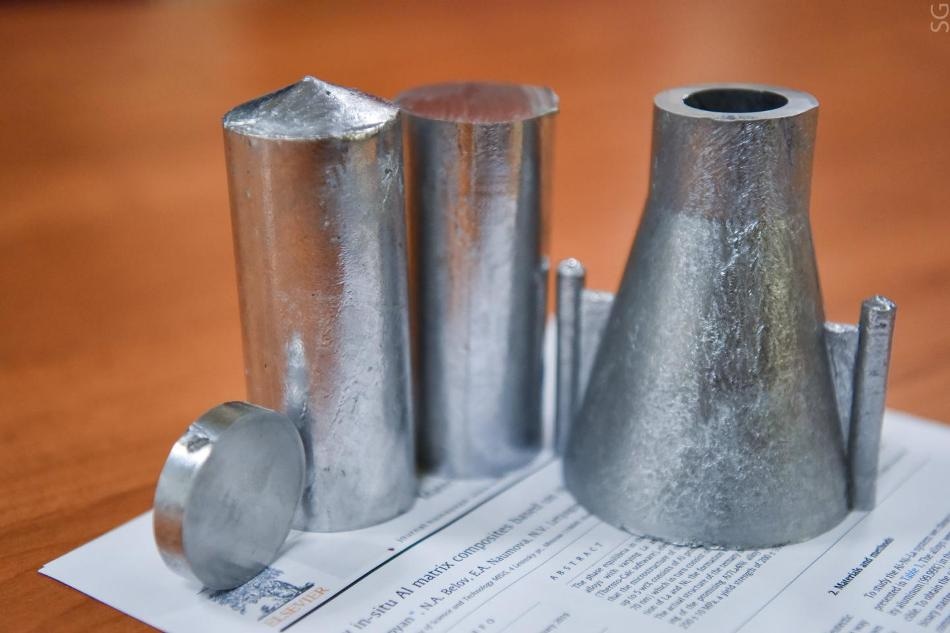May 27 2019
Aluminum is considered as one of the most potential materials in the automobile and aeronautics sectors. Now at the National University of Science and Technology “MISIS”, researchers have discovered a simple and efficient method for strengthening composite materials based on aluminum.
 Details made of Al-Ni-La composite material. (Image credit: Sergey Gnuskov/NUST MISIS)
Details made of Al-Ni-La composite material. (Image credit: Sergey Gnuskov/NUST MISIS)
The researchers doped aluminum melt with lanthanum and nickel and eventually developed a special material that integrates the advantages of both standard alloys and composite materials—that is, lightness, strength, and flexibility. An article on this study has been reported in Materials Letters.
Lighter materials are required for faster and lighter aircraft. Aluminum, or more precisely, aluminum-based composites are regarded as one of the most potential materials.
The research team from NUST MISIS scientific school “Phase Transitions and Development of Non-Ferrous Alloys” developed an innovative and robust Al-Ni-La composite for the automobile and aircraft sectors. To this aluminum melt, doping elements were added to form unique chemical compounds that additionally created a robust reinforcing structure.
Our research group, led by Professor Nikolai Belov, has worked on the creation of aluminum-based composites for many years. Al-Ni-La composite is one of such projects, aimed at creation of ‘natural’ aluminum-based composite material with more than 15% vol. of doping elements. A feature of the new development is the high reinforcing ability of the chemical compounds with ultrafine structure: the diameter of the reinforcing elements does not exceed several tens of nanometers. Previously, researchers were limited to the study of systems in which it is obviously impossible to obtain an effective reinforcing structure. Or they manufactured composite materials by labor-intensive powder metallurgy methods (sintering of powders), or liquid-phase technologies of kneading nanoparticles in the melt.
Torgom Akopyan, Study Co Author, Researcher, Department of Metal Forming, NUST MISIS
At present, aluminum is mainly reinforced with the aid of nanopowders; however, this process is rather costly and takes a considerable amount of time, where the outcome does not invariably justify the means spent. For instance, with the strength increased by just 5%-20%, such an indicator as plasticity, on the other hand, can reduce by tens of percent or even a number of times. Moreover, the particles themselves are extremely large, measuring between 100 nm to 1–2 µm, and their % volume is also low.
The development of the Al-Ni-La composite by NUST MISIS researchers overcomes the issue of low density and non-uniform reinforcement of powder” composites—if a melting method is utilized, the doping particle’s diameter does not go beyond 30 to 70 nm after the crystallization of the Al-Ni-La composite. Particles are evenly distributed due to “natural” crystallization, creating a reinforcing structure. Therefore, the composite turns out to be more flexible and robust when compared to its “powder” analogs.
Our composite already demonstrates better characteristics than its analogues, including foreign ones. However, we are not going to stop here, and in the future we plan to continue working on the creation of more advanced, complex (3-, 4—and more phase) and cheap composites, the production cycle of which will include the use of aluminum of technical purity and cheaper alloying components.
Torgom Akopyan, Study Co Author, Researcher, Department of Metal Forming, NUST MISIS
According to the researchers, the recommended material can be mainly utilized in the automobile and aeronautics sectors, and in the design of contemporary robotics, including copters, where it is important to reduce the drone’s weight. Owing to the peculiarities of the formation of the structure, the recommended material can be used for producing intricate parts through 3D printing. Moreover, the latest developments may be strategically significant from an economic viewpoint. Currently, the export of primary aluminum is the major share of profit in the Russian aluminum sector. The development of novel high-tech advancements with increased added value will boost profits by expanding local and international markets for aluminum consumption.